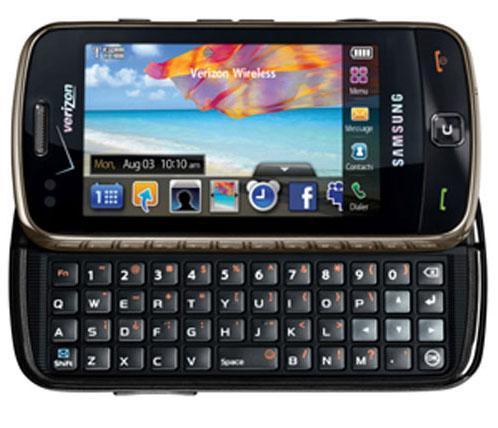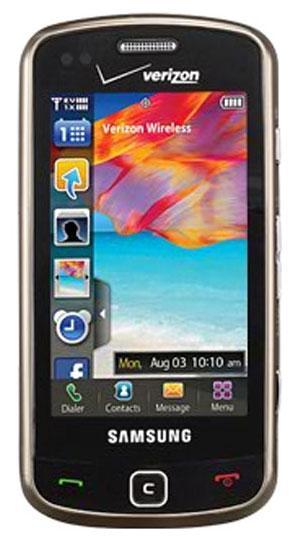What's Good:
Absolutely stunning AMOLED screen, 3.5mm headphone jack instead of Samsung's proprietary connection, EVDO Rev. A, good camera.
What's Bad:
The layout of the QWERTY keyboard is a bit frustrating due to the placement of the navigational keys.
Coming in as the replacement to the error-prone Samsung Glyde, the new Samsung Rogue fell into the marketplace with a reputation to defend, and more importantly, in a year where the competition in the "feature phone" field has significantly increased. It's no secret that Verizon took a more hands-off approach with the device's UI this time around, in favor of Samsung's TouchWiz offering. This is also the first non-smartphone device from the carrier to require a data package. Is it worth the extra money per month?
Like many of the popular QWERTY devices on the market today, the Samsung Rogue is a sliding phone, offering a nice copper and silver finish that enhances the style of the device. The colors serve to make the device neutral in regards to demographic appeal - it would fit into the hands of a texting teenager, or a busy businessperson with ease. Coming in at 4.29 inches long by 2.17 inches wide by 0.65 inch thick, the Rogue weighs 4.94 ounces, making it slightly lighter than a smartphone.

The left side of the device houses the volume rocker and a proprietary charging port, while the right side sports a 3.5mm headphone jack, lock button, voice recognition shortcut, speaker key, media shortcut key (still camera and video camera), and the microSD card slot (with support for up to a 16 GB card). On the front of the device, the send, end and clear keys can be found.
The 3.1-inch AMOLED display is absolutely stunning, supporting 262,000 colors and offering 480 x 800 pixels. The display is a great size, and we were quite impressed with it. Pictures looked absolutely fantastic on the display, colors were incredibly rich, and text seemed as if it was jumping off of the screen. On the topic of displays, the Rogue ships with a resistive touchscreen, and while our preference lies in a capacitive touchscreen (like that found on the iPhone) for accuracy reasons, we had little trouble getting used to the Rogue's screen. Scrolling was easy, and with one gesture, the device would smoothly roll through the menus. Every now and then, the screen wouldn't recognize a gesture, but it didn't happen often.

Including as few accessories as possible seems to be the trend these days, and the Rogue falls in line with the industry standard, offering an AC adapter, USB cable (which doubles as the charging cord), and an instruction manual.
The Samsung Rogue ships with the company's TouchWiz user interface in place of the typical Verizon software option. Overall, TouchWiz was a pleasure to use, offering widgets such as Facebook, MySpace, Twitter, and YouTube. Widgets can either be placed in the "toolbar" (which is on the left side of the main screen, and can be hidden for more screen real estate), or on the main screen itself. The bottom part of the screen houses four on-screen fixed options: Dialer (phone), Contacts, Message, and Menu. The level of customization that the device offers is impressive. As a high-end feature phone, the Rogue is capable of running Verizon's numerous software offerings, such as V CAST Video, V CAST Music with Rhapsody, and VZ Navigator.
Slide the screen to the right to discover the full QWERTY keyboard. While the keys are roomy and a pleasure to use, the placement of the keys themselves were somewhat of a drawback. Due to a somewhat strange placement of the navigational keys, the A-L row on the keyboard is shifted to the left and the Z-M row is sandwiched in with the spacebar, throwing off the traditional QWERTY design. It's something that we became accustomed to over time, but for the first week, was quite a challenge.
The Samsung Rogue offers a 3.0-megapixel camera, and in our testing, image quality was above average. Shipping with a flash and portrait mirror, our test pictures came out well. Neat features include 10x digital zoom, five shooting modes, self-timer, autofocus, eight different picture resolutions, three quality settings, and numerous color effects. Additionally, the camera offers four shutter tones, with one being a silent option. Video quality was decent; thanks to two different recording modes, video can be recorded with the intent of sending via MMS (lower quality), or for saving (better quality).
We tested the Rogue in the Charlotte area, and call quality was very good. Callers had no problem hearing us, and in turn, call quality was clear on our end as well. When we went to a known fringe area, we found calls to sound equally clear, despite the Rogue showing no bars of service. We successfully paired the Plantronics Voyager Pro Bluetooth headset to the device, and were able to enjoy the stereo Bluetooth capabilities. The Rogue's speakerphone was quite clear as well; we tested the device in a busy gas station, and we could hear our callers well. Though there was some reported background noise, callers told us that they could understand the conversation.
Thanks to Verizon's strong EVDO Rev. A service, we were incredibly pleased with data speeds. The PhoneDog homepage loaded in 19 seconds, and other data-intensive tasks performed well throughout our testing. The HTML web browser was a joy to use; scrolling was easy, with little to no lag. What's more, the browser supports copy and paste functionality, as well as Flash Lite for watching streaming videos.
Estimated talk time is 4.7 hours, and in our testing, battery life was reasonable. With moderate use encompassing text messaging, calling, and the occasional internet browsing, we were able to make it about a day and a half before the device powered down. With little to no use, the device lasted just under five days. As with any phone, these numbers will vary with the level of usage that they're subjected to between charging cycles, but the Rogue should please most users.
The Samsung Rogue is a great high-end device for someone who wants a feature-rich phone without the smartphone price tag. Furthermore, it does what few phones have successfully done: it bridges several demographics in its appeal. From texting teenagers to corporate businessmen, the Rogue seems to fit well in any category. Battery life is more than strong enough to make it through a day of moderate use, so those that aren't in the office on a regular basis owe the Rogue a once-over.